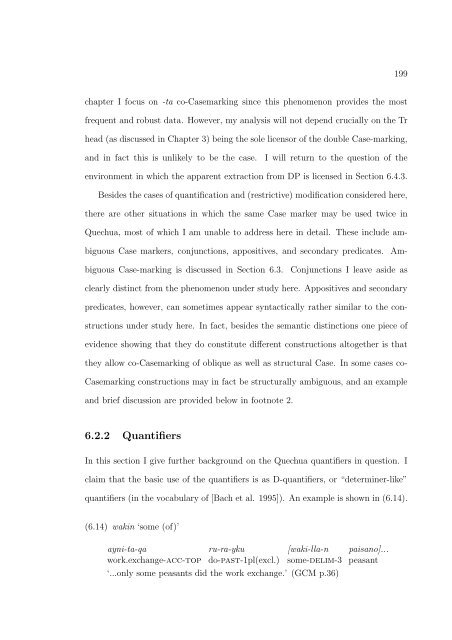the syntax and semantics of relativization and quantification
the syntax and semantics of relativization and quantification
the syntax and semantics of relativization and quantification
Create successful ePaper yourself
Turn your PDF publications into a flip-book with our unique Google optimized e-Paper software.
199<br />
chapter I focus on -ta co-Casemarking since this phenomenon provides <strong>the</strong> most<br />
frequent <strong>and</strong> robust data. However, my analysis will not depend crucially on <strong>the</strong> Tr<br />
head (as discussed in Chapter 3) being <strong>the</strong> sole licensor <strong>of</strong> <strong>the</strong> double Case-marking,<br />
<strong>and</strong> in fact this is unlikely to be <strong>the</strong> case. I will return to <strong>the</strong> question <strong>of</strong> <strong>the</strong><br />
environment in which <strong>the</strong> apparent extraction from DP is licensed in Section 6.4.3.<br />
Besides <strong>the</strong> cases <strong>of</strong> <strong>quantification</strong> <strong>and</strong> (restrictive) modification considered here,<br />
<strong>the</strong>re are o<strong>the</strong>r situations in which <strong>the</strong> same Case marker may be used twice in<br />
Quechua, most <strong>of</strong> which I am unable to address here in detail. These include ambiguous<br />
Case markers, conjunctions, appositives, <strong>and</strong> secondary predicates. Ambiguous<br />
Case-marking is discussed in Section 6.3. Conjunctions I leave aside as<br />
clearly distinct from <strong>the</strong> phenomenon under study here. Appositives <strong>and</strong> secondary<br />
predicates, however, can sometimes appear syntactically ra<strong>the</strong>r similar to <strong>the</strong> constructions<br />
under study here. In fact, besides <strong>the</strong> semantic distinctions one piece <strong>of</strong><br />
evidence showing that <strong>the</strong>y do constitute different constructions altoge<strong>the</strong>r is that<br />
<strong>the</strong>y allow co-Casemarking <strong>of</strong> oblique as well as structural Case. In some cases co-<br />
Casemarking constructions may in fact be structurally ambiguous, <strong>and</strong> an example<br />
<strong>and</strong> brief discussion are provided below in footnote 2.<br />
6.2.2 Quantifiers<br />
In this section I give fur<strong>the</strong>r background on <strong>the</strong> Quechua quantifiers in question. I<br />
claim that <strong>the</strong> basic use <strong>of</strong> <strong>the</strong> quantifiers is as D-quantifiers, or “determiner-like”<br />
quantifiers (in <strong>the</strong> vocabulary <strong>of</strong> [Bach et al. 1995]). An example is shown in (6.14).<br />
(6.14) wakin ‘some (<strong>of</strong>)’<br />
ayni-ta-qa<br />
work.exchange-acc-top<br />
ru-ra-yku<br />
do-past-1pl(excl.)<br />
[waki-lla-n<br />
some-delim-3<br />
‘...only some peasants did <strong>the</strong> work exchange.’ (GCM p.36)<br />
paisano]...<br />
peasant
















